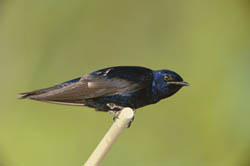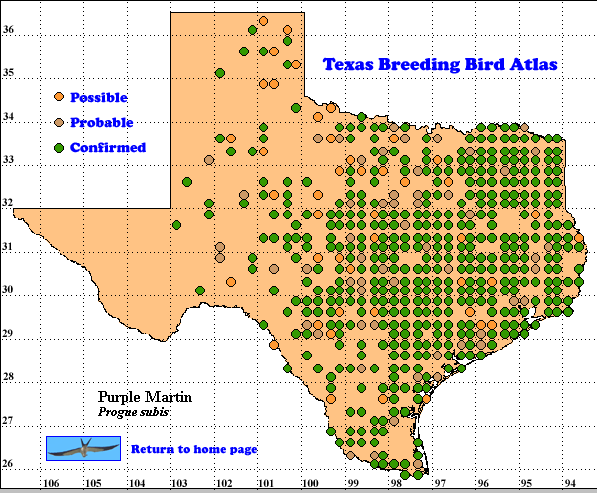Progne subis
The Purple Martin is the largest of the eight swallow species that regularly occur in Texas (Ray 2001). As elsewhere east of the Rocky Mountains, Purple Martins in Texas have abandoned their ancestral habit of nesting in natural cavities (Hill 1992, Hill 1993); they breed almost exclusively in backyard birdhouses (Brown 1997). In areas west of the Great Plains, the species still nests almost exclusively in woodpecker holes or other natural cavities (Brown 1997), including mountain ranges in neighboring New Mexico (Ray and Yaksich 1999).
DISTRIBUTION: In Texas, the breeding range of the Purple Martin includes all of the state except for the Trans Pecos region, and most of the western third of the Panhandle and South Plains (Ray 1995, Ray 2001). TBBA data support this distribution and demonstrate breeding is most widespread in the eastern one-half of the state. Locally, tree canopy, and lack of properly located and managed, man-supplied housing limit nesting by Purple Martins.
Breeding is easily confirmed, as Purple Martins in Texas nest exclusively in backyard bird housing, and usually in conspicuously open situations. In addition, adult Purple Martins are quite active and vocal, especially in the vicinity of the nesting site. Upon arrival in spring, male Purple Martins claim and advertise their cavities. Arriving females select a cavity, essentially inheriting the male associated with that cavity (Johnston and Hardy 1962). Purple Martins are a single-brooded species, second broods are rare (Brown 1997).
SEASONAL OCCURRENCE: The spring arrival of Purple Martins typically begins in mid-January through early February in South Texas, while they may not appear in northern areas of the Panhandle until late March (Ray 2001). Arrivals typically continue at individual colonies for 16-22 weeks (Hill 2001). Timing of arrival is age and sex-related, as older age classes generally precede younger birds, and males generally precede females of their respective age class. In Texas, second-year Purple Martins arrive about two months after the earliest birds arrive (Brown 1997). When new colonies are established, it is usually by these late-arriving second-year birds (Hill 2001).
Timing of egg-laying depends on arrival date, but has been reported as early as 6 April in North Texas (Brown 1997), and 3 May in the Panhandle (JDR). According to TBBA records, the latest nesting record for Texas is 5 August.
The clutch of 3-7 eggs is laid on a pad-like nest of coarse materials, lined with green leaves. Often, the nest contains a mud dike, which is constructed at the cavity entrance and slopes downward toward the rear of the cavity. The incubation period is sixteen days, and the young receive care in the cavity for 26-28 days. Upon fledging, the young are kept together, and fed for an additional 1-2 weeks. Soon after fledging, premigratory aggregations form, and most Purple Martins have left the state by the end of September (Ray 2001).
BREEDING HABITAT: Today, Purple Martins nest almost exclusively in bird housing located within 30 m (100 ft) of human residences (Hill 1990a), or other areas frequented by people (e.g., parks, schools, etc.). The birds tend to avoid birdhouses placed near trees or shrubs and, in fact, will likely abandoned houses if trees or shrubs encroach on them (Hill 1990a,b). A nearby water source is not a prerequisite for having Purple Martins, but they seem to be most numerous around water, and will travel several kilometers to drink, bathe, and capitalize on the abundance of flying insects normally found around water (Ray 1995).
STATUS: In Texas, the Purple Martin population remained relatively stable during the period 1966-2000 (Sauer et al. 2001). Installation of martin houses has allowed for a range expansion westward into northwest Texas in recent years (Ray 1995).
In the absence of management (see Ray 2001), nest site competition and reduced productivity caused by House Sparrows (Passer domesticus) and European Starlings (Sturnus vulgaris) represent the biggest threat to nesting Purple Martins (Brown 1981, Hill 1993).
Short-term regional declines usually result from weather-related mortality (Peterjohn and Sauer 1997).
Text by James D. Ray (ca. 2002)
Literature Cited
Brown, C. R. 1978. Double-broodedness in Purple Martins in Texas. Wilson Bull. 90: 239-247, 657.
Brown, C. R. 1981. The impacts of starlings on Purple Martin populations in unmanaged colonies. Am. Birds. 35: 266-268.
Brown, C. R. 1997. Purple Martin (Progne subis). In The birds of North America, No. 287 (A. Poole and F. Gill, eds.) The Birds of North America, Inc., Philadelphia.
Hill, J. R., III. 1990a. The top ten reasons why people fail to attract Purple Martins. Purple Martin Update. 2(3): 28. Purple Martin Conservation Association. http://purplemartin.org/update/Reprints.html
Hill, J. R., III. 1990b. The top twelve reasons why people lose their Purple Martins. Purple Martin Update. 2(4): 28-29. Purple Martin Conservation Association. http://purplemartin.org/update/Reprints.html
Hill, J. R., III. 1992. Thanks to Native Americans, Purple Martins underwent a complete tradition shift. Purple Martin Update. 3(4): 26-27. Purple Martin Conservation Association. http://purplemartin.org/update/Reprints.html
Hill, J. R., III. 1993. Thirteen ways martins are unique. Purple Martin Update. 4(2): 28-29. Purple Martin Conservation Association. http://purplemartin.org/update/Reprints.html
Hill, J. R., III. 2001. The breeding range, wintering range, northward migration pathways, and arrival schedule of the Purple Martin. Purple Martin Update. 10(1): 6-7. Purple Martin Conservation Association. http://purplemartin.org/update/Reprints.html
Johnston, R. F., and J. W. Hardy. 1962. Behavior of the Purple Martin. Wilson Bull. 74: 243- 262.
Peterjohn, B. G., and J. R. Sauer. 1997. Trends and abundance patterns in the Purple Martin: results from the North American breeding bird survey, 1966-1994. Purple Martin Update. 8(1): 26-27. Purple Martin Conservation Association. http://purplemartin.org/update/Reprints.html
Ray, J. D. 1995. Purple Martins in northwest Texas. Purple Martin Update. 6(3):10-12. Purple Martin Conservation Association.
Ray, J. D. 2001. The Purple Martin and its management in Texas. Second edition. Texas Parks and Wildl. Bull. PWD BK W7000-254 (1/01). Austin.
Ray, J. D., and G. R. Yaksich. 1999. Tree-nesting Purple Martins in northeastern New Mexico. Purple Martin Update 9(2) :8-11. Purple Martin Conservation Association.
Sauer, J. R., J. E. Hines, and J. Fallon. 2001. The North American Breeding Bird Survey, Results and Analysis 1966 – 2000. Version 2001.2, USGS Patuxent Wildlife Research Center, Laurel, MD. http://www.mbr-pwrc.usgs.gov/bbs/bbs.html

